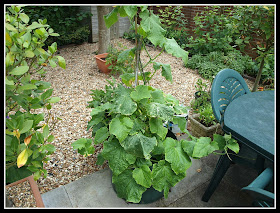The bloggers in question are Egretta Wells of both Cottage Creative Living and Paintings by Egretta Wells; and Kelli Boyles of Kelli's Northern Ireland Garden.
 |
| Me with Kelli (left) and Egretta (right) |
Kelli set up her blog at very much the same time that I started Mark's Veg Plot, so we have had a very similar journey through the blogging world, and we compare notes via blog comments more or less on a daily basis. Amongst other achievements she has recently had an article called "The Art of Gardening" published on the website of Culture Northern Ireland. In this she explains why she loves gardening and how she became keen on it. Well worth a read, because I expect many of you will have had similar experiences.
Egretta is a very accomplished artist, working in a variety of media such as watercolours, oils and pastels and she is a generally all-round artistic person - as well as being an enthusiastic amateur gardener. She is forever setting her hand to some new creative venture. She once did a painting of Mallard drake based on one of my photos, which she saw on my blog. I bought this picture from her and it now hangs in my Living Room alongside the original photo.
Egretta and Kelli, accompanied by their husbands Bob and Mark, were over in England for a few days, on a coach tour centred on Stratford-on-Avon, from where they were to visit the Costwold hills and surrounding areas, and their proximity was an opportunity too good to miss so Jane and I drove up to Stratford to meet them. Maybe they used my blogposts from earlier this year called "Stratford on Avon" and "Minster Lovell and the Cotswolds" to do some prior research?!
Kelli's husband Mark is quite interested in entering competitions (aka contests), which is of course the area in which Jane specialises, so he and she had plenty to talk about too. Just in case you didn't already know this, Jane is the editor of the well-known comping magazine The Competition Grape Vine. If you're interested in this sort of thing, why not visit her website or her blog and find out more?
Here's a group photo, taken in the lounge of the visitors' hotel.
 |
| Mark (Boyles), Kelli, Egretta, Bob, Jane |
The container is a re-purposed 1-litre ice-cream tub, and it currently contains approx 500g of cherry tomatoes, which is what I am picking from my 4 plants about every 2 -3 days.
Nice to meet you all, Kelli, Egretta, Mark, and Bob. I hope the coach tour turned out well; I hope you liked the Cotswolds area, and I hope to see some pictures of it on your blogs before very long!


































































